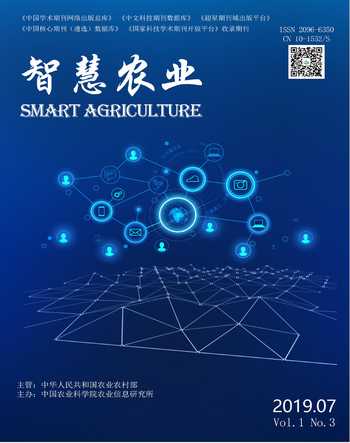太阳能杀虫灯物联网研究现状与展望
李凯亮 舒磊 黄凯 孙元昊 杨帆 张宇 霍志强 王彦飞 王心怡 卢巧玲 张亚成
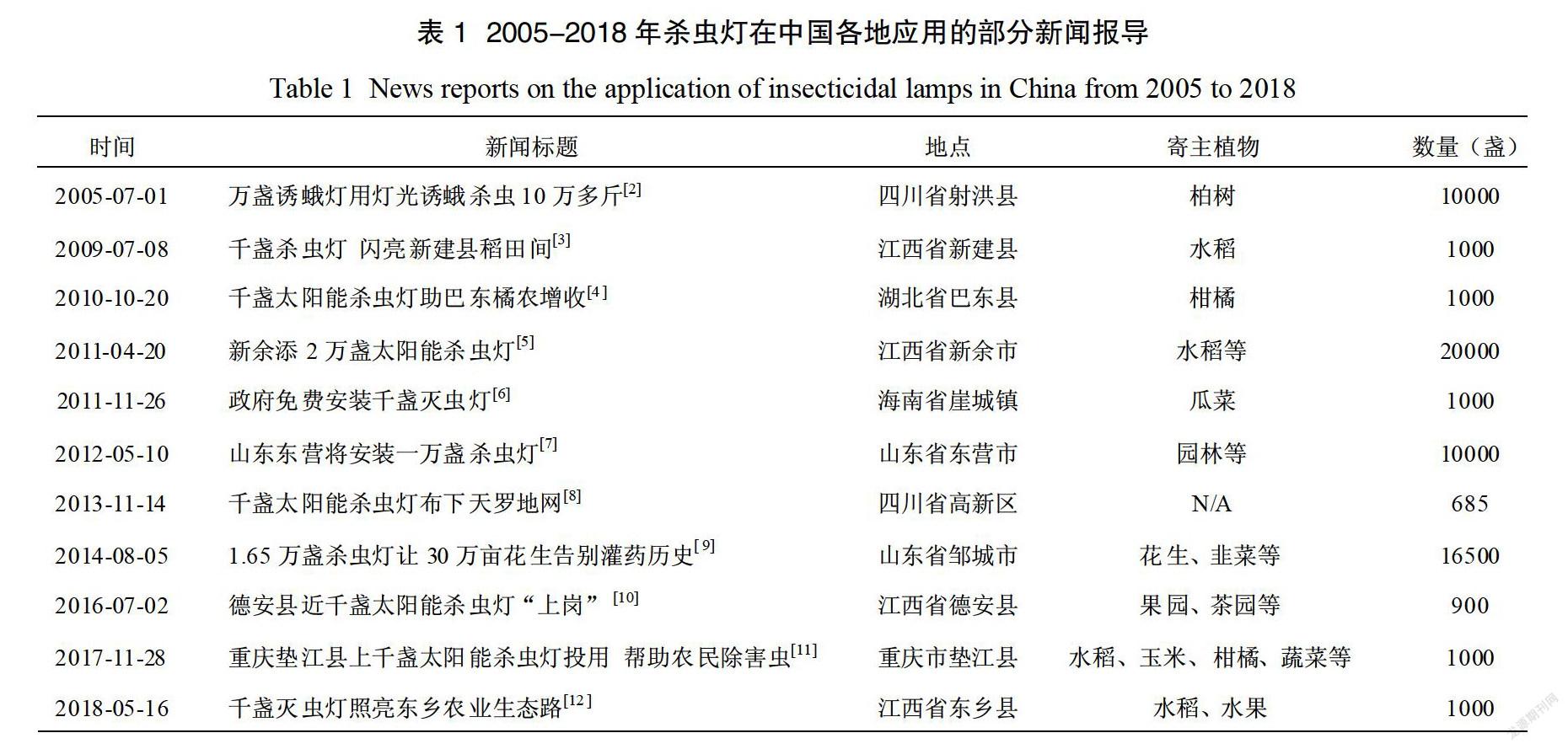

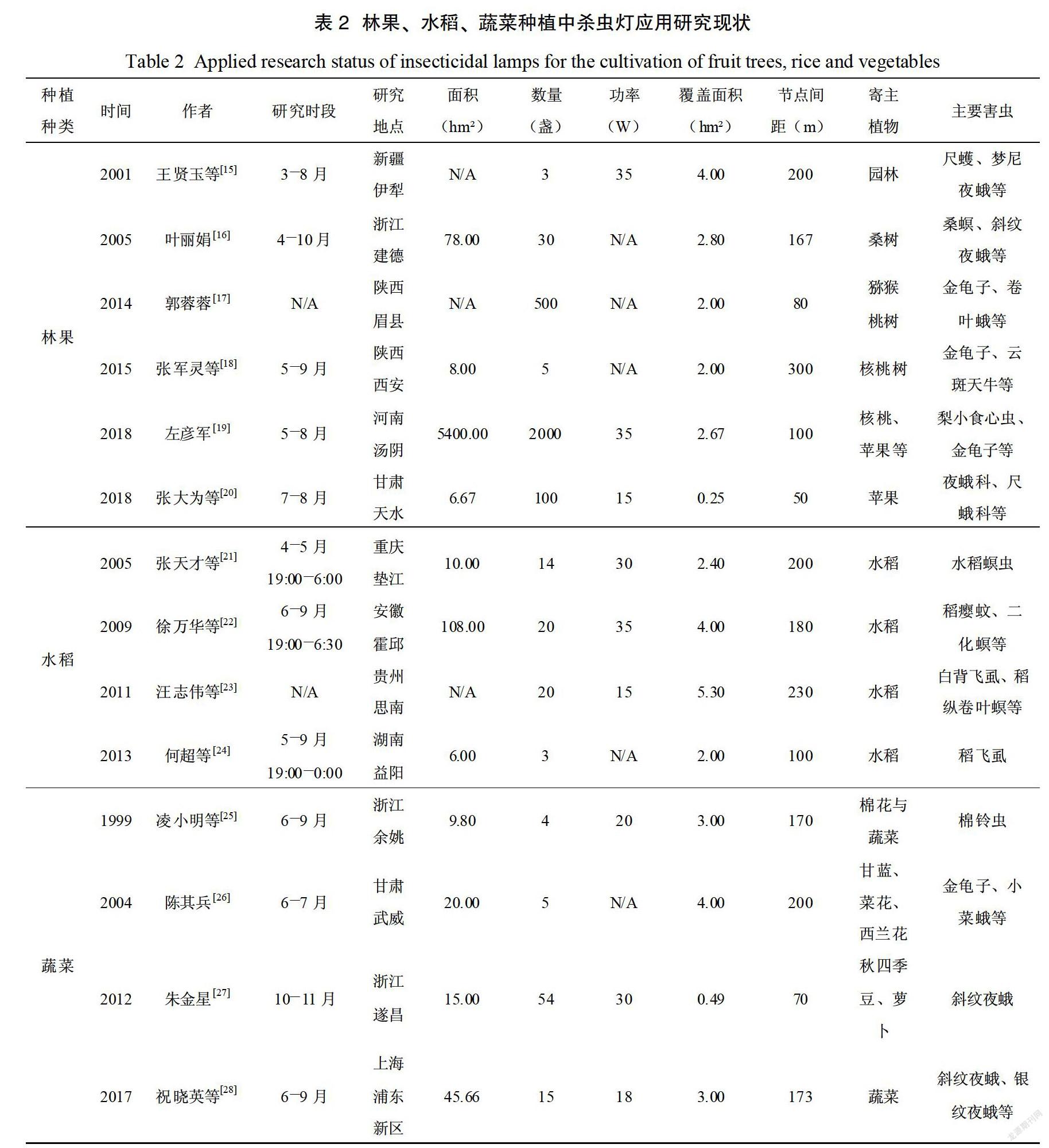
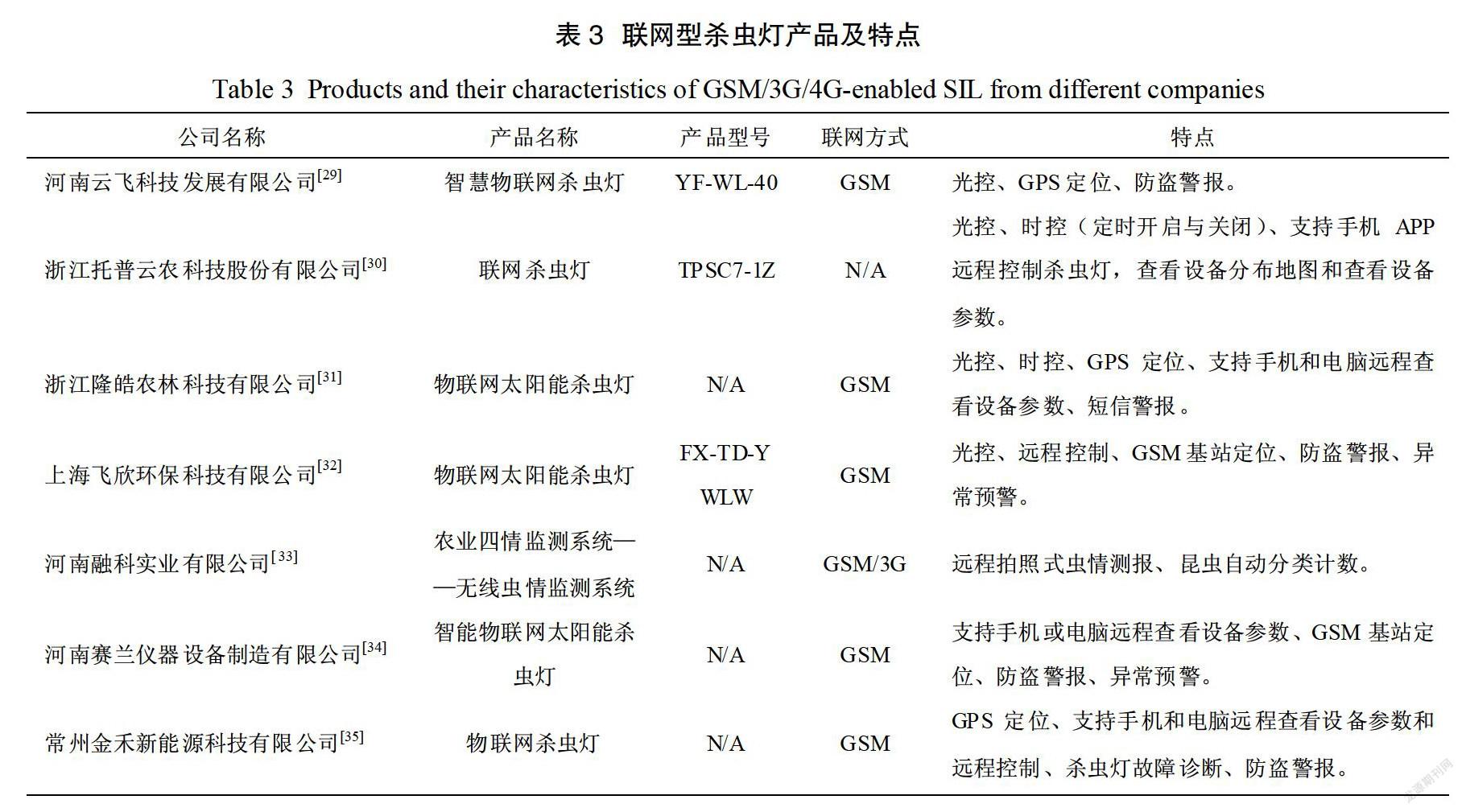
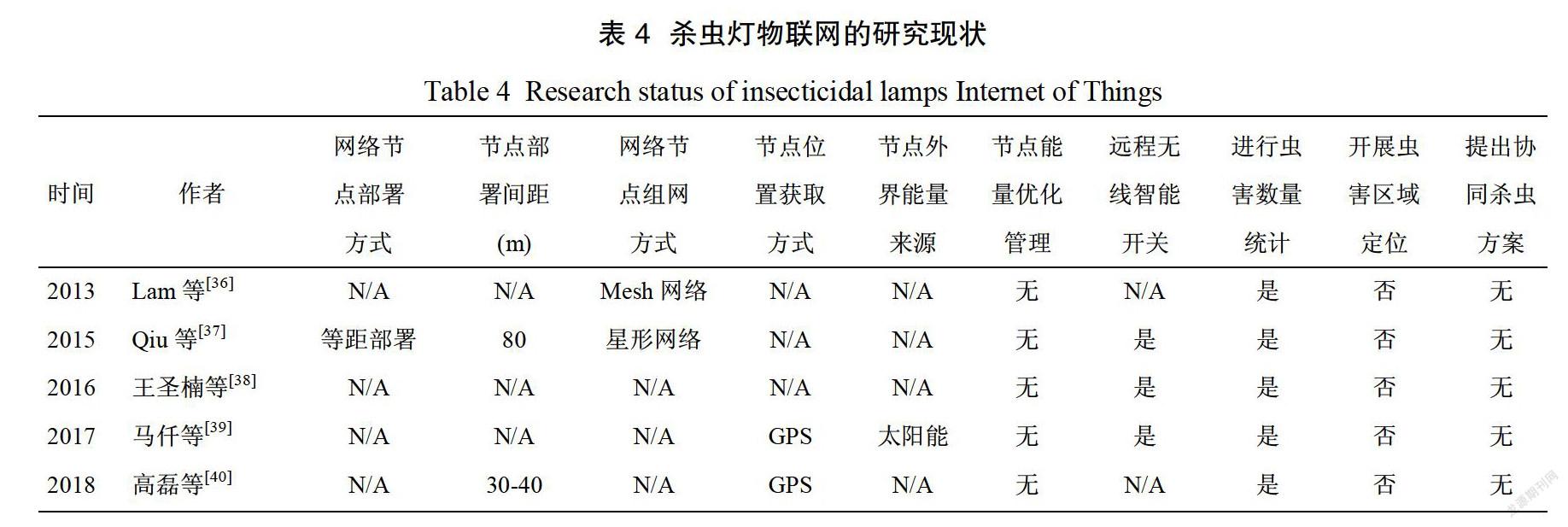

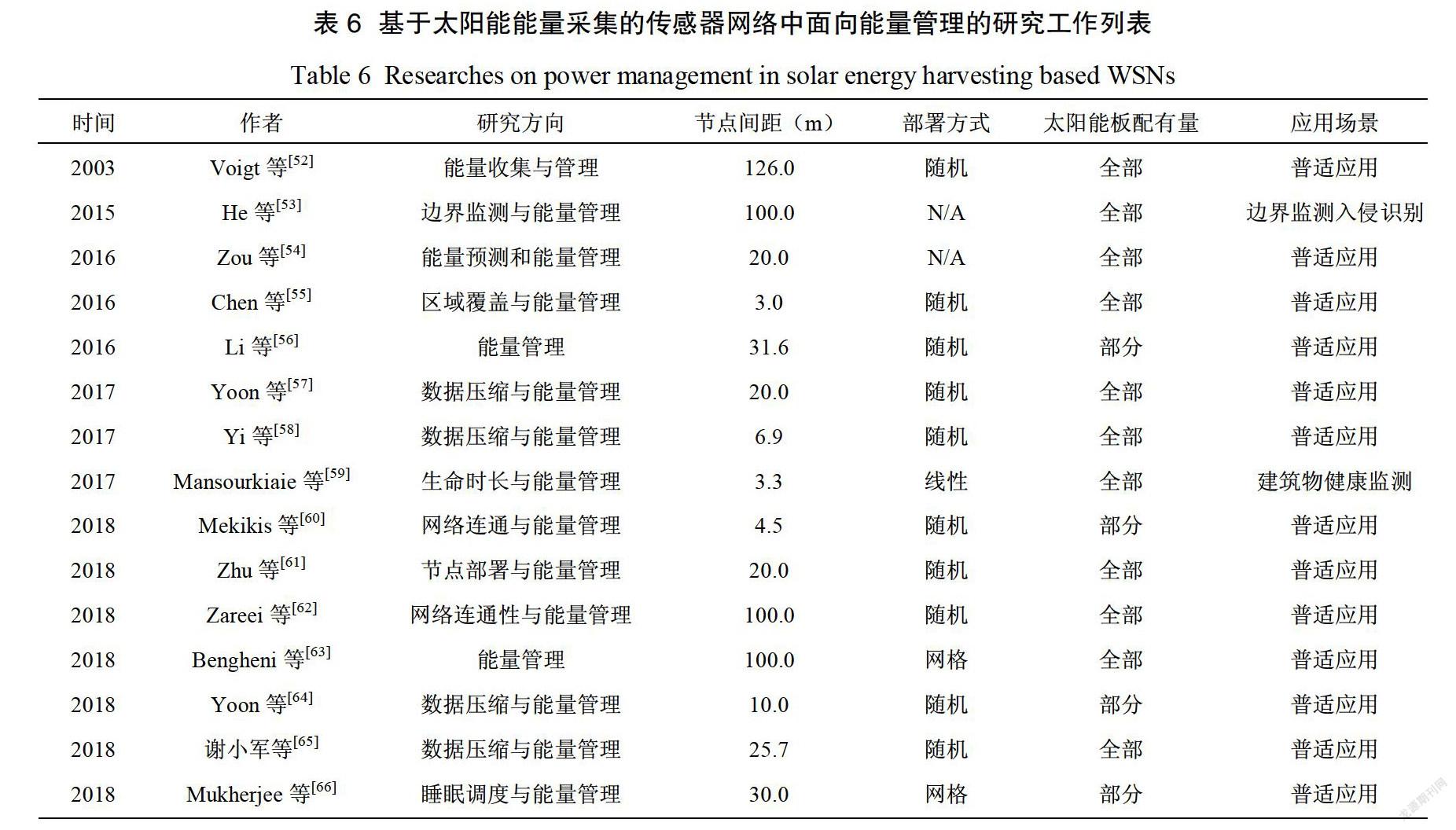
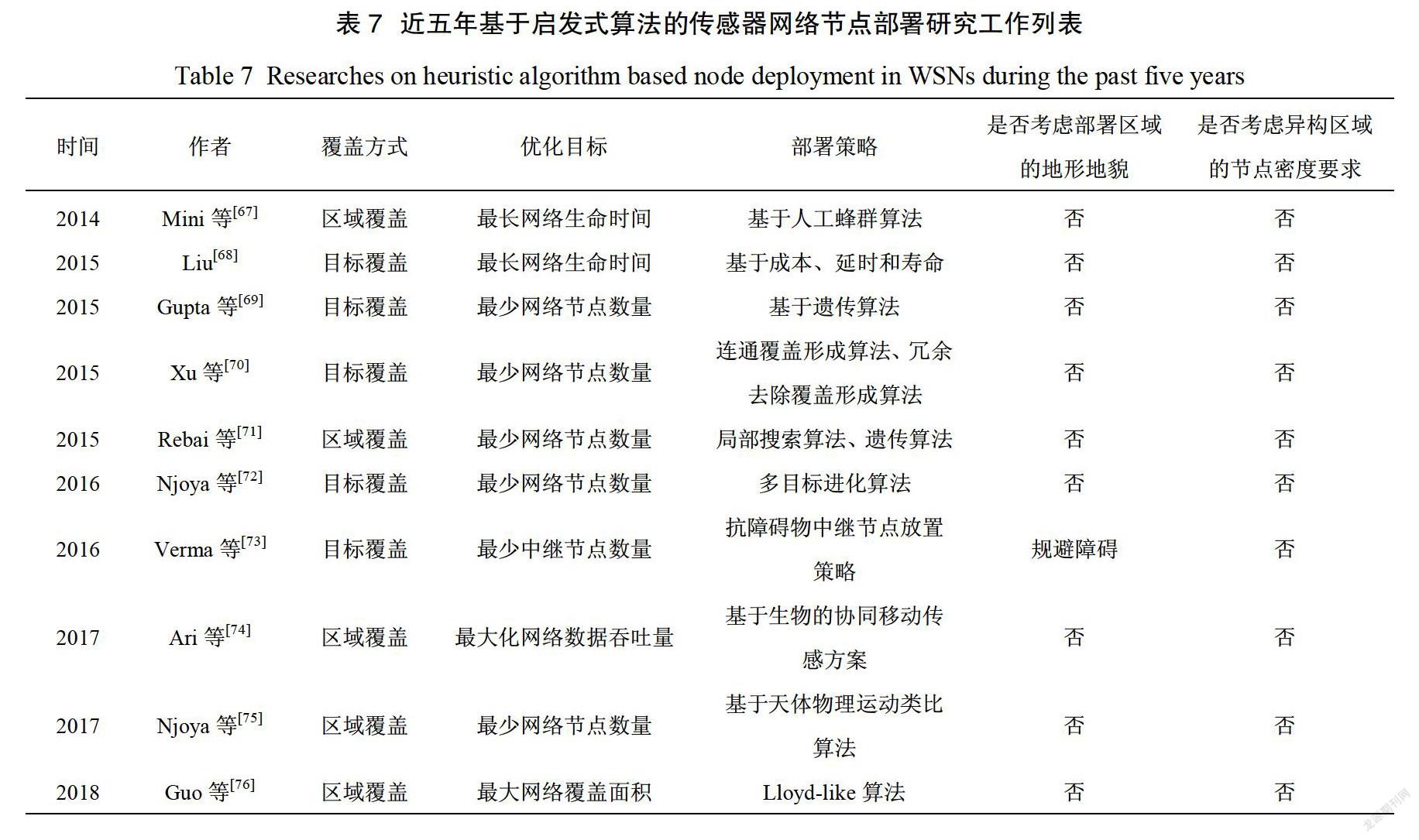

摘 要:太阳能杀虫灯在农业趋光性害虫受灯光引诱并接触金属网时释放高压脉冲电流杀灭害虫,可有效减少施用农药造成的环境污染和食品安全问题。本文介绍了利用无线传感器网络技术提升太阳能杀虫灯在农业迁飞性趋光害虫防治领域的应用效果,明确提出了一种新型农业物联网——太阳能杀虫灯物联网。首先,从杀虫灯在国内农业生产中的应用研究现状出发,总结了杀虫灯在林果、水稻和蔬菜等作物生产种植中的部署特点和杀虫工作时段分布情况;其次,分析了现有联网型太阳能杀虫灯节点的产品特点和杀虫灯物联网研究现状;然后,结合太阳能杀虫灯的能量采集方式、田间部署特点,综合分析了基于太阳能能量采集方式的传感器网络研究现状和基于启发式的传感器网络节点部署研究现状;最后,探讨了太阳能杀虫灯物联网的节点部署、能量预留管理、虫害爆发区域边界定位、虫情数据抗干扰传输等关键研究问题,并对太阳能杀虫灯物联网在农业生产中的应用进行了总结和展望。
关键词:农业虫害防治;太阳能杀虫灯;无线传感器网络;农业物联网
中图分类号:S-1 文献标志码:A 文章编号:201905-SA001
李凯亮, 舒 磊, 黄 凯, 孙元昊, 杨 帆, 张 宇, 霍志强, 王彦飞, 王心怡, 卢巧玲, 张亚成. 太阳能杀虫灯物联网研究现状与展望[J]. 智慧农业, 2019,1(3): 13-28.
Li K, Shu L, Huang K, Sun Y, Yang F, Zhang Y, Huo Z, Wang Y, Wang X, Lu Q, Zhang Y. Research and prospect of solar insecticidal lamps Internet of Things[J]. Smart Agriculture, 2019, 1(3): 13-28. (in Chinese with English abstract)
1 引言
中国是农业大国,保障农业生产稳定有序地开展是社会安定的基础。然而,受到气候变化、工业活动等因素影响,迁飞性害虫诱发的农业虫害日益频繁,严重影响农业生产安全。昆虫的迁飞是在一定虫态,周期性、长距离、有一定方向的飞行行为,也是导致一些地区某种虫害突然爆发,造成农作物严重减产的重要原因。迁飞性害虫的防治和实现自动化虫情测报对于农业生产安全和虫害防治研究领域至关重要。
现阶段中国农业虫害防治主要采用施用农药的方式,但由于长期滥用农药使得害虫产生抗药性,陷入了“施用农药——害虫产生抗药性——加大施用农药剂量”的恶性循环。施用农药的方式不可避免地污染了自然水体、土壤及生态环境,且可能残留在农产品表面,危害人们生命安全。随着人们环境保护意识的提高,以及对绿色无公害的农产品日益增长的需求,探索在农业生产过程中绿色环保的虫害防治方式势在必行。
近年来,利用太阳能杀虫灯对农业迁飞性趋光害虫防治的研究和应用已经得到世界各国政府农业部门、农业生产企业和科研机构的极大关注,并给农业生产中迁飞性趋光害虫的防治带来了新模式,成为了新的研究热点。例如,农业农村部全国农作物重大病虫害防治预案(农办农〔2005〕11号)中明确提出“可选用高压汞灯、频振式杀虫灯等诱杀成虫,降低成虫基数,减轻幼虫防治压力”[1]。
农业迁飞性害虫迁飞飞行主要发生在成熟期(有飞行能力)至生殖前期(交配、产卵),这是太阳能杀虫灯开展杀虫工作的主要时段。在此时段前后,太阳能杀虫灯使用黑光灯吸引迁飞性趋光害虫,并在害虫接触到金属网时释放高压脉冲电流杀灭害虫。
这种新型绿色农业病虫害防治方式可以有效地降低农药施用率,已经在全国各个地区得到了广泛应用,如表1所示。可以看到,自2005年以来杀虫灯在我国农业生产中被广泛应用,江西省新余市就部署了2万盏太阳能杀虫灯用于水稻的趋光性害虫防治[5],这进一步给当地带来了重大的社会影响。
随着“精准农业”和“智能农业”的快速发展,以及农业信息化需求的不断增长,无线传感器网络(Wireless Sensor Networks, WSN)技术已广泛应用于农情信息采集、农业装备智能控制等方面[13,14]。WSN适用于大规模部署和区域监测,可以很容易地与太阳能杀虫灯(Solar Insecticidal Lamps,SILs)结合,形成一种新型的农业物联网——太阳能杀虫灯物联网(Solar Insecticidal Lamps Internet of Things:SIL-IoTs)。太阳能杀虫灯物联网节点结构图如图1所示。在每个太阳能杀虫灯物联网节点中,可以集成无线通信模块(例如,ZigBee)通过网络及时地向终端用户报告所在位置的害虫密度信息。白天,太阳能杀虫灯物联网节点(以下简称“节点”)利用太阳能电池板收集能量并转化为电能存储到蓄电池中。夜间,节点开启诱虫灯吸引附近的趋光性害虫并在害虫接触金属网时释放高压脉冲电流杀灭害虫,通过统计脉冲电流的次数可以估算区域内虫口密度。除了虫口密度信息外,无线通信模块还可收集更多信息,例如杀虫灯节点的太阳能电池板能量收集情况、杀虫灯的电池剩余容量等信息。
通过在现有的太阳能杀虫灯上增加无线通信模块,太阳能杀虫灯物联网可以提高迁飞性趋光害虫防治效果、实现农业害虫灾害预警和为农业生产区域的精确施药提供数据支撑与决策依据。
本文总结了杀虫灯应用研究现状、现有企业生产的联网型杀虫灯产品特点和杀虫灯物联网研究现状。首先分析了现有杀虫灯的研究进展和应用特点。然后调研并分析了现有企业生产的联网型杀虫灯功能及产品特点,总结了现有杀蟲灯物联网的研究现状。接着从太阳能杀虫灯的能量采集方式、部署特点出发,结合无线传感器网络的研究现状,综合分析了基于太阳能能量采集的传感器网络研究现状和基于启发式的传感器网络节点部署研究现状;最后结合农业生产现状和太阳能杀虫灯的特点,提出了太阳能杀虫灯物联网的四个关键研究问题,并对太阳能杀虫灯物联网在农业虫害防治领域的未来进行了展望。
2 杀虫灯应用研究现状
目前,杀虫灯在我国已有较多的应用研究,且主要集中在林果、水稻以及蔬菜等经济作物的生产种植中。表2中列举了杀虫灯的研究时段、研究地点、具体作物和主要害虫等信息,给出了杀虫灯应用区域、覆盖面积、部署数量、功率和节点间距等关键参数。
通过对表2进行分析,得到以下结果:
(1)杀虫灯在农林业领域中已在不同地域内广泛应用,可适用于多种经济作物生产中趋光性害虫的防治。
(2)部署标准无据可依:现有杀虫灯的部署位置主要依靠工程安装人员根据部署现场的情况决定(例如,地形、周边遮挡物等),表2的研究中没有明确提出节点部署方案,部署位置和节点间距的选择相对随意,具体体现为表2中同种作物不同节点间距(即覆盖面积与部署数量之比)的差异。
(3)缺乏工作时段自动调整技术:从表2可以看到,对于不同经济作物,其面临的主要趋光性害虫种类不同;对于不同种类的趋光性害虫,其主要活跃时间(月份、夜晚时段)不同。因此,对于轮作或间作套种的种植方式,需要根据种植的作物种类和该时间阶段内的主要害虫种类,调整杀虫灯的工作时间段从而实现较好的杀虫效果。
(4)杀虫灯节点间距与无线传感器节点通信半径相近:当杀虫灯的部署规模较大时,例如,郭蓉蓉[17]500盏,左彦军[19]2000盏,张大为等[20]100盏,朱金星[27]54盏,其节点间距基本在70~100m之间,与现有大多数的无线传感器网络节点通信半径相近。
3 太阳能杀虫灯物联网产品及研究
现状
3.1 联网型太阳能杀虫灯产品现状
在日益增长的对绿色无污染农产品需求的驱动下,部分生产企业瞄准太阳能杀虫灯的广阔应用市场,对原有太阳能杀虫灯进行升级改造,使得太阳能杀虫灯可以更有效地开展杀虫工作。例如,对太阳能杀虫灯集成了电压脉冲计数模块和GSM通信模块来实现虫情信息的自动采集和上报。表3列举了部分公司的联网型太阳能杀虫灯产品及其特点。
通过对这些企业生产的联网型杀虫灯进行综合对比分析,得到以下结论:
(1)已有的联网型太阳能杀虫灯都是使用移动蜂窝网络(GSM網络)的方式进行数据传输,暂未出现无线传感器网络技术(例如Zigbee网络)的杀虫灯物联网产品。此种方式存在以下问题:①使用GSM数据传输的方式大幅度地增加了杀虫灯节点的设备成本和后期维护成本(需要一直缴纳GPRS流量费用);②大规模部署的太阳能杀虫灯对其所在区域的移动蜂窝网络的通信质量和信号覆盖要求较高。这些问题的存在不利于太阳能杀虫灯物联网的普及。
(2)缺乏工作时段自适应调整机制:已有的联网型太阳能杀虫灯节点仅能通过手机或客户端远程设定工作时间段,此类杀虫灯节点降低了手动调整工作时段的人力成本。但在长期恶劣天气、有阴影长期遮挡等无法获取足够能量来源的情况下,或者由于突发虫害时较多的能量消耗,杀虫灯节点将因能量耗尽而停止工作,无法继续杀虫。因此,杀虫灯节点需要根据所在区域虫情密度、害虫活动规律、天气情况、剩余能量等数据,基于强化学习等理论进行自我学习,智能决策自身最佳工作时段,从而实现“智能化”控制。
(3)缺乏虫害爆发区域定位技术:已有的联网型太阳能杀虫灯节点在虫害爆发时仅能实现单个节点的异常虫情报警,这种方式的准确性不如太阳能杀虫灯物联网中网络节点相互协同感知的方式,且无法通过节点间共享虫情数据以便精确判定虫害爆发区域,而无法为严重虫害区域的精准施药提供参考依据。
3.2 杀虫灯物联网研究现状
太阳能杀虫灯物联网是新兴事物,利用太阳能杀虫灯物联网研究迁飞性趋光害虫迁徙和优化杀虫工作也处于初始研究阶段。目前已有部分研究者基于不同电力供应方式的杀虫灯物联网开展相关研究工作,如表4所示。
2013年,Lam等[36]描述了使用基于传感器网络的办法监测褐飞虱在越南湄公河三角洲地区的迁徙,将杀虫灯和传感器网络结合,利用传感器网络感知并传输褐飞虱的分布信息。2015年,Qiu等[37]描述了部署在鱼塘周边,由不同类型杀虫灯组成的一种“星网”,通过雷达来定位飞虫位置,并在飞虫靠近杀虫灯时通过无线控制的方式,按照距离远近逐步开启杀虫灯诱虫,最终在鱼塘上方进行杀虫。2016年,王圣楠等[38]提到了目前杀虫灯在防治农林害虫的应用中所面临的不足,并提出把杀虫灯技术与物联网技术相结合对于虫害防治非常有利,是未来发展的方向,其中提到“将物联网技术应用于杀虫灯的控制,实现杀虫灯的启闭适应生态植保和农艺的需求,将是杀虫灯发展的契机”。2017年,马仟等[39]为解决传统杀虫灯的无人看管模式和低效率的人工维护等问题,提出了一种新型的基于无线传感器网络杀虫灯软硬件设计,提出通过多点配合式的杀虫模式灵活控制整个杀虫系统,从而达到最优的杀虫效果,但具体优化方案并未展开讨论。2018年,高磊[40]利用GPS定位、虫口密度等数据采集模块,设计了基于物联网的果园病虫害信息监测系统,提出了一种利用无线传感器网络探测果园害虫分布的方法。
通过对这些前期相关工作的综合分析,可以得到以下结论:
(1)杀虫灯与物联网结合这个概念是在2013年提出来的,并在2017年和2018年有学者尝试了基于无线传感器网络的杀虫灯软硬件设计。
(2)已有利用无线传感器网络节点间的通信功能来协调控制杀虫灯的启闭,从而达到不同虫害状况下更好的杀虫效果。
(3)从表4统计结果来看,除马仟采用太阳能作为节点能量来源外,其他学者研究中没有明确的“节点外界能量来源”信息,但马仟等人并未研究太阳能杀虫灯物联网节点能量优化管理问题。
(4)现有研究均可获取区域内虫害数量信息,但暂无利用虫情数据开展虫害区域精确定位的研究,也暂无研究太阳能杀虫灯物联网的网络协同杀虫方案。
在此,需要特别指出有两篇文献[41,42],虽然他们是研究“基于物联网技术的农业虫害智能监控系统”,但是其中使用的不是将杀虫灯作为虫害的计数模块,他们使用的是DATA-LYNX型昆虫自动计数站,其主要的工作方式是:“内部由昆虫计数传感器和数據采集器组成,运用昆虫激素吸引相应昆虫撞击传感器,形成脉冲信号来计数”。因此,这两篇文献不作为相关工作。
4 基于太阳能能量采集的传感器网
络的研究现状及分析
近几年,出现了很多基于太阳能能量采集的传感器网络的研究,通过收集这方面的文献并进行整理,对文献中明确给出节点部署方式和节点部署密度的论文加以分析,主要按照研究内容将整理的论文分为两大类:①数据传输;②能量管理。分别如表5和表6所示。
在以上两个表格中,对相关研究论文中的节点间距、部署方式、太阳能板配有量以及应用场景这四个方面进行了整理,通过综合分析,可以得到以下结论:
(1)除了He等[53]和Mansourkiaie等[59]这两个研究工作明确指出了特定的研究领域,其他相关研究工作面向的都是普适应用(即普遍适用于多种不同应用场景。例如,工业控制、环境监测和医疗监护等场景),无法满足太阳能杀虫灯物联网的节点部署要求,例如,倾向于部署在田埂上以避免占用农田和降低后期维护成本,且倾向于部署在害虫密集区以提高虫害防治效果。
(2)如表5和表6所示,这些研究工作主要通过节点部署位置、通信数据压缩、对节点进行睡眠调度等方式减少网络通信的能量消耗从而延长网络生命时间。但尚未出现针对太阳能杀虫灯物联网此类特定农业领域内的应用场景开展能量预留管理的研究。例如,根据作物主要害虫的活动规律和未来的能量采集情况进行动态能量管理,从而延长太阳能杀虫灯物联网的网络生命时间。
5 基于启发式算法的传感器网络节
点部署研究现状
如何在不同约束条件下优化传感器网络节点对不同目标的部署方案,是无线传感器网络领域的一个关键和基础性的研究课题,目前已有较多的研究工作。
在早期阶段,研究者通常使用数学建模的方式将这类优化问题(例如,最大网络覆盖问题)转化为单目标或多目标优化问题,然后采用整数线性规划方法来解决。这样的研究方法在相对简单的网络节点部署约束条件下被证明是行之有效的,但不适用于更复杂约束条件的场景。
在农业生产中的复杂地形、地貌和杀虫灯对异构作物不同的部署密度需求、网络通信需求等多重条件约束下,太阳能杀虫灯物联网节点部署无法通过整数线性规划的方法给出更好的优化方案。因此,需要考虑采用启发式算法,例如,遗传算法(Genetic Algorithm)、蚁群算法(Ant Colony Algorithm)、蜂群算法(The Bee Colony Algorithm)、粒子群算法(Particle Swarm Algorithm)和生物地理算法(Biogeographic Algorithm)等,在可接受的计算成本内获得较好的网络节点优化部署策略。基于这样的考虑,对近五年采用启发式算法的网络节点优化部署的相关研究工作整理如表7所示。
在表7中,对这些论文中覆盖方式、优化目标、是否考虑部署区域地形地貌因素等方面进行整理分析,可以得到以下结论:
(1)Gupta等[69]、Xu等[70]、Rebai等[71]、Njoya
等[72, 75]开展的研究工作,都是从“以最少网络节点数量”的研究目标出发来实现最大的区域覆盖,这与实现太阳能杀虫灯物联网有效工作范围对区域全覆盖的研究需求相近,可以起到很好的借鉴作用。
(2)这些研究都没有考虑目标区域的不规则地形以及区域内可能存在的异构作物对杀虫灯不同的部署密度要求,例如,杀虫灯倾向于部署在靠近存在水体或者背风等害虫较为集中的区域。此外,考虑到部署后的维护成本,太阳能杀虫灯物联网节点应该部署在农民(或技术人员)更
容易到达的位置(例如,田埂或果园的路边)。因此,在为目标区域提供有效的覆盖质量前提下,应倾向于将太阳能杀虫灯物联网节点部署在田埂或果园的路旁。表7中这些研究都没有针对“倾向于将部分节点部署到特定区域”的研究内容。Verma等[73]考虑了规避多重障碍物节点部署策略,研究了存在多重障碍下保障网络连通性的中继节点部署方案,其研究目标与上述太阳能杀虫灯物联网节点的部署要求相反,但其研究思路对上述的太阳能杀虫灯物联网倾向性部署具有参考价值。
6 关键研究问题与展望
6.1 关键研究问题
太阳能杀虫灯物联网在杀虫灯被广泛应用的基础上,结合无线传感器网络技术优化杀虫效果和自动虫情测报,可实现农业虫害监测的信息化、自动化,在农业虫害防治领域具有巨大的发展潜力和应用价值。但在实际应用普及过程中也将面临着一些问题和挑战,未来需要着重在以下四个方面开展研究:
(1)多约束条件下的太阳能杀虫灯节点部署方案
目前,太阳能杀虫灯的部署位置主要由工程安装人员根据现场地形和杀虫灯的有效覆盖范围等条件而确定。这种部署方式缺乏宏观的虫害防治规划,且常面临以下三方面问题:①部分杀虫灯的有效覆盖范围重叠,增加了不必要的部署成本;②部分种植区域无法得到杀虫灯的有效覆盖而使得害虫有隙可乘,为虫害爆发埋下了隐患;③无法根据区域内种植的异构作物(如种植了玉米、小麦等不同种类作物)对杀虫灯的不同部署密度要求而进行差异化部署(杀虫灯部署密度因作物而异)。
为了最小化对农业生产的不利影响和降低日常维护成本,杀虫灯需尽量部署在田埂上,同时还需对存在水体或者背风等害虫相对密集的区域倾向性布置杀虫灯。因此,如何快速生成太阳能杀虫灯物联网节点部署位置图,使区域内的杀虫灯实现最优虫害防治效果是急需解决的问题之一。
(2)保障杀虫灯基本工作时间的能量自适应控制策略
趋光性害虫的活动规律受到较多外界因素的影响。但目前市场上的太阳能杀虫灯只能按照出厂设定或后期人工设定的工作时段开展害虫防治工作,无法根据不同季节、不同区域的虫口密度智能调节工作时段,特别是在趋光性害虫向某一区域群体迁入而造成突发虫害时,无法及时开灯杀虫,防治效果不佳。
另一方面,太阳能杀虫灯节点开展杀虫任务需要消耗较多的能量,这些能量来自于杀虫灯自身蓄电池的剩余能量和太阳能电池板的能量采集。然而,太阳能杀虫灯节点会面临长时间恶劣天气、阴影遮挡等能量采集不佳的情况,无法维持太阳能杀虫灯的长时间杀虫工作。而趋光性害虫在夜晚的活动规律存在活动高峰期和低谷期时段,因此维持太阳能杀虫灯物联网节点整晚长时间的开启是不必要的,在能量采集情况不佳时需要智能调节杀虫灯的工作时段从而节省能量,保障杀虫灯在害虫活动高峰期的正常运行,达到更好的杀虫效果。
(3)虫害爆发区域精确定位技术
迁飞性害虫的危害特点是突然发生并短时间爆发成灾,且局部虫害爆发后害虫迅速迁飞到其他区域并繁殖,呈现出多点爆发、扩散迅速的特点。因此,快速划分不同虫害受灾程度、多点爆发的虫害区域,为精准施用农药及时控制严重虫害的方式提供参考依据,是极为重要的研究工作。
(4)严重虫害情况下杀虫灯密集高压放电时段的网络数据抗干扰传输
杀虫灯在害虫接触金属网的瞬间会释放高压脉冲电流以杀灭害虫,伴随产生了强电磁波脉冲。在杀虫放电密集时段(如图2所示),网络内太阳能杀虫灯物联网节点杀灭害虫产生不规律的强电磁波脉冲会严重干扰数据传输,使得区域内虫害信息无法及时地传送出去,影响虫情测报工作。因此,太阳能杀虫灯物联网节点如何避开杀虫灯高压放电密集时段,对通信时段进行自适应调整以保障数据传输,是急需解决的问题之一。
6.2 展望
太阳能杀虫灯物联网是“精准农业”和“智慧农业”的典型应用,是结合无线传感器网络技术的一种新型农业虫害防治模式。其未来发展可借鉴已有的传感器网络节点部署优化算法对太阳能杀虫灯物联网节点部署方案进行优化。利用人工智能理论和相关技术对节点工作时段进行智能化控制,为现有杀虫灯优化部署和能量智能管理的实现提供理论依据,从而达到更好的虫害防治效果。通过无线传感器网络进行虫情信息自动测报,结合空间分析技术,在虫害爆发时快速精准地定位虫害爆发区域,为虫情监测、虫害爆发区域的精准施药提供数据支撑和决策依据。
基于上述技术的实现,太阳能杀虫灯物联网对于农业迁飞性趋光害虫可达到更好的虫害防治效果,保障农业生产安全。
参考文献
[1] 中华人民共和国农村农业部. 2005年全国农作物重大病虫害防治预案[EB/OL]. (2005-04-20) [2019-04-20].
Ministry of Agriculture and Rural Affairs of the People’s Republic of China. National plan for prevention and control of major crop pests and diseases in 2005[EB/OL]. (2005-04-20) [2019-04-20]. http://www.moa.gov.cn/nybgb/2005/dsiq/201806/t20180617_6152431.htm.
[2] 千家照明網. 万盏诱蛾灯用灯光诱蛾杀虫10万多斤[EB/OL]. (2005-07-01) [2019-04-20].
Qianjia Lighting. Ten thousand insecticidal lamps killed pests more than 50,000 kg[EB/OL]. (2005-07-01) [2019-04-20]. http://lighting.qianjia.com/html/2005-07/14
937.html.
[3] 大江网—江西日报. 千盏杀虫灯闪亮新建县稻田间[EB/OL]. (2009-07-08) [2019-04-20].
Dajiang—Jiangxi Daily. One thousand insecticidal lamps were deployed in rice fields in Xinjian County[EB/OL]. (2009-07-08) [2019-04-20]. http://info.lamp.hc360.com/
2009/07/08104755736.shtml.
[4] 千盏太阳能杀虫灯助巴东橘农增收[EB/OL]. 人民网, (2010-10-20) [2019-04-20].
The orange farmers’ income increased with the help of insecticidal lamps[EB/OL]. Renmin, (2010-10-20) [2019-04-20]. http://hb.people.com.cn/GB/203881/13003
653.html.
[5] 大江网—江西日报. 新余添2万盏太阳能杀虫灯[EB/OL]. (2011-04-20) [2019-04-20].
Dajiang—Jiangxi Daily. 20,000 solar insecticidal lamps were deployed in Xinyu City [EB/OL]. (2011-04-20) [2019-04-20]. http://jiangxi.jxnews.com.cn/system/2011/
04/20/011640638.shtml.
[6] 南海网—南国都市报. 政府免费安装千盏灭虫灯[EB/OL]. (2011-11-26) [2019-04-20].
Nanhai-Nanguo Metropolitan Daily. Thousands of insecticidal lamps were deployed by the government free of charge [EB/OL]. (2011-11-26) [2019-04-20]. http://news.eastday.com/s/20111226/u1a6277157.html.
[7] 中国花卉报. 山东东营将安装一万盏杀虫灯[EB/OL]. (2012-05-10) [2019-04-20].
China Flower News. Ten thousand insecticidal lamps will be deployed in Dongying, Shandong Province[EB/OL]. (2012-05-10) [2019-04-20]. http://www.cnzicai.com/
news/detail/2012510/106208.html.
[8] 四川太一新能源. 千盏太阳能杀虫灯布下天罗地网[EB/OL]. (2013-11-14) [2019-04-20].
Sichuan Taiyi New Energy. One thousand insecticidal lamps were deployed[EB/OL]. (2013-11-14) [2019-04-
20]. http://sctaiyi.com/news/hyzs/1117.html.
[9] 农村大众. 1.65万盏杀虫灯让30万亩花生告别灌药历史[EB/OL]. (2014-08-5) [2019-04-20].
Rural Public. 165,500 insecticidal lamps let 20,000 hm2 of peanuts bid farewell to the history of pesticide[EB/OL]. (2014-08-5) [2019-04-20]. http://paper.dzwww.com/ncdz/content/20140805/Articel05002MT.htm.
[10] 中国江西网. 德安县近千盏太阳能杀虫灯“上岗”[EB/OL]. (2016-06-28) [2019-04-20].
Jiangxi News. Nearly 1000 insecticidal lamps were deployed in De'an County [EB/OL]. (2016-06-28) [2019-04-20]. http://jj.jxnews.com.cn/system/2016/06/
28/014999266.shtml.
[11] 墊江日报. 重庆垫江县上千盏太阳能杀虫灯投用 帮助农民除害虫[EB/OL]. (2017-11-28) [2019-04-20].
Dianjiang Daily. Thousands of solar insecticidal lamps in Dianjiang County were used to help farmers get rid of pests [EB/OL]. (2017-11-28) [2019-04-20]. http://www.yndtjj.com/ne/2017-11-28/15118353128519.html.
[12] 东乡地宝通. 千盏灭虫灯照亮东乡农业生态路[EB/OL]. (2018-05-16) [2019-04-20].
Dongxiang Dibaotong. One thousand insecticidal lamps were deployed in Dongxiang County[EB/OL]. (2018-05-16) [2019-04-20]. http://www.sohu.com/a/231
869363_200784.
[13] Liu B. Wireless sensor network applications in precision agriculture[J]. Journal of Agricultural Systems, Technology, and Management, 2018, 29: 25-37.
[14] Madli R, Hebbar S, Heddoori V, et al. Intelligent irrigation control system using wireless sensors and android application[J]. International Journal of Computer, Electrical, Automation, Control and Information Engineering, 2016, 10(8): 1424-1430.
[15] 王贤玉, 翁晓梅. 频振式杀虫灯在园林害虫防治上的应用[J]. 植物保护, 2001, (3): 47-48.
Wang X, Weng X. Application of frequency vibration insecticidal lamp in the control of garden pests[J]. Plant Protection, 2001, (3): 47-48.
[16] 叶丽娟. 应用频振式杀虫灯防治桑园害虫效果[J]. 中国蚕业, 2005, 26(1): 36-37.
Ye L. Effect of frequent vibration insecticidal light on control of insert pests in mulberry field[J]. Silkworm Industry of China, 2005, 26(1): 36-37.
[17] 郭蓉蓉. 太阳能杀虫灯在猕猴桃果园应用优点多[J]. 农机科技推广, 2014, (4): 42-43, 46.
Guo R. Solar insecticidal lamp has many advantages in kiwifruit orchard[J]. Agricultural Machinery Technology Promotion, 2014, (4): 42-43, 46.
[18] 张军灵, 李荣周, 魏耀辉. 太阳能杀虫灯在核桃害虫防治上的应用研究[J]. 陕西林业科技, 2014, (1): 19-23.
Zhang J, Li R, Wei Y. Application of solar insecticide lamps in prevention and control of walnut pests[J]. Shaanxi Forestry Science and Technology, 2014, (1): 19-23.
[19] 左彦军. 频振式杀虫灯在汤阴县果树生产中的应用[J]. 山西林业, 2018, (4): 44-45.
Zuo Y. Application of frequency-vibration insecticidal lamps in fruit production in Tangyin County[J]. Shanxi Forestry, 2018, (4): 44-45.
[20] 张大为, 罗进仓, 金社林, 等. 不同光谱杀虫灯对苹果园害虫诱杀效果及灯下昆虫种群结构分析[J]. 中国农学通报, 2018, 34(31): 140-146.
Zhang D, Luo J, Jin S, et al. Analysis of the trapping effect of different spectral insecticidal lamps on pests in apple orchards and the structure of insect population under the lamp[J]. China Agricultural Science Bulletin, 2018, 34(31): 140-146.
[21] 张天才, 黄丕娇. 频振式杀虫灯对水稻二化螟的诱杀效果[J]. 中国农技推广, 2005, (5): 47-48.
Zhang T, Huang P. The trapping effect of frequency-vibration insecticidal lamp on rice stem borer[J]. China Agricultural Technology Promotion, 2005, (5): 47-48.
[22] 徐万华, 胡守奎, 姚骏, 等. 频振式杀虫灯诱杀水稻害虫试验研究[J]. 现代农业科技, 2009, (15): 143-44.
Xu W, Hu S, Yao J, et al. Experimental study on trapping rice pests by frequency-vibration insecticidal lamp[J]. Modern Agricultural Science and Technology, 2009, (15): 143-44.
[23] 汪志伟, 卢方林, 雷凌云. 太阳能频振式杀虫灯对水稻害虫控制效果及效益分析[J]. 现代农业科技, 2011, (21): 208.
Wang Z, Lu F, Lei L. Control effect and benefit analysis of solar frequency vibrating insecticidal lamp on rice pests[J]. Modern Agricultural Science and Technology, 2011, (21): 208.
[24] 何超, 方宝华, 张玉烛, 等. 扇吸式诱虫灯与频振式杀虫灯对稻田防虫效果比较[J]. 杂交水稻, 2013, 28(3): 58-63.
He C, Fang B, Zhang Y, et al. Comparison of insecticidal effects of fan-sucking insect traps and frequency-vibration insecticidal lamps on rice fields[J]. Hybrid Rice, 2013, 28(3): 58-63.
[25] 凌小明, 馮新军, 陆军良. 频振式杀虫灯对棉铃虫的诱杀效果[J]. 浙江农业科学, 2000, (2): 30-32.
Lin X, Lin X, Lu J. The trapping effect of frequency-vibration insecticidal lamp on cotton bollworm[J]. Zhejiang Agricultural Sciences, 2000, (2): 30-32.
[26] 陳其兵. 频振式杀虫灯在无公害蔬菜生产中的应用技术[J]. 中国瓜菜, 2006, (5): 456-457.
Chen Q. Application technology of frequency- vibration insecticidal lamp in the production of pollution-free vegetables[J]. China Cucurbits and Vegetables, 2006, (5): 456-457.
[27] 朱金星. 豆类蔬菜斜纹夜蛾绿色防控技术研究[D]. 浙江: 浙江大学, 2012.
Zhu J. Study on green control technology of bean vegetable spodoptera litura[D]. Zhejiang: Zhejiang University, 2012.
[28] 祝晓英, 杜利强. 频振式太阳能杀虫灯在蔬菜害虫防治上的应用[J]. 上海蔬菜, 2017, (2): 45-46.
Zhu X, Du L. Application of frequency-vibration solar insecticide lamps in prevention and control of vegetable pests[J]. Shanghai Vegetables, 2017, (2): 45-46.
[29] 河南云飞科技发展有限公司. 智慧物联网杀虫灯[EB/OL]. [2019-04-20].
Henan Yunfei Science and Technology Development Co., Ltd.. Intelligent internet of things insecticidal lamp[EB/OL]. [2019-04-20]. http://www.tynpzs.com/cpzx/
tynpzs/273.html.
[30] 浙江托普云农科技股份有限公司. 联网杀虫灯[EB/OL]. [2019-04-20].
Zhejiang Tuopu Yunnong Technology Co., Ltd.. GSM/3G/4G-enabled insecticidal lamp[EB/OL]. [2019-
04-20]. http://www.tpwlw.com/product/cp_84.html.
[31] 浙江隆皓农林科技有限公司. 物联网太阳能杀虫灯[EB/OL]. [2019-04-20].
Zhejiang Longhao Agroforestry Technology Co., Ltd.. Internet of things solar insecticidal lamp[EB/OL]. [2019-04-20]. http://www.dwdds.com/product/283.html.
[32] 上海飞欣环保科技有限公司. 物联网太阳能杀虫灯[EB/OL]. [2019-04-20].
Shanghai Feixin Environmental Protection Technology Co., Ltd.. Internet of things solar insecticidal lamp[EB/OL]. [2019-04-20]. http://www.xxps.net/p_wlwshachongdeng.html.
[33] 河南融科实业有限公司. 无线虫情监测系统[EB/OL]. [2019-04-20].
Henan Rongke Industrial Co., Ltd.. Wireless insect monitoring system[EB/OL]. [2019-04-20]. http://www.hnrksy.com/fuwuxiangmu/181.html.
[34] 河南赛兰仪器设备制造有限公司. 智能物联网太阳能杀虫灯[EB/OL]. [2019-04-20].
Henan Sailan Instrument and Equipment Manufacturing Co., Ltd.. Intelligent internet of things solar insecticidal lamps [EB/OL]. [2019-04-20]. http://www.slyqa.com/a/
cp/fz/tynscd/473.html.
[35] 常州金禾新能源科技有限公司. 物联网杀虫灯[EB/OL]. [2019-04-20].
Changzhou Jinhe New Energy Technology Co., Ltd.. Internet of things insecticidal lamp[EB/OL]. [2019-04-20]. http://www.jinhexny.com/products/31.html.
[36] Lam H B, Phan T T, Vuong L H, et al. Designing a brown planthoppers surveillance network based on wireless sensor network approach[J]. Computer Science, 2013:
1-6.
[37] Qiu Z, Qiu P, Zhu Q, et al. Insect trapping method based on progressive star network[J]. Wireless Sensor Network Applications in Engineering, 2015, 11(9): 56-60.
[38] 王圣楠, 胡憲亮, 王西南. 杀虫灯防治农林害虫应用技术分析及展望[J]. 山东林业科技, 2016, (5): 85-88.
Wang S, Hu X, Wang X. Analysis and prospect of the application technology of insecticidal lamp in the control of agricultural and forestry pests[J]. Journal of Shandong Forestry Science and Technology, 2016, (5): 85-88.
[39] 马仟, 田茂, 唐文龙. 基于WSN的分布式太阳能杀虫灯远程控制系统研究与设计[J]. 物联网技术, 2017, (2): 77-79, 83.
Ma Q, Tian M, Tang W. Research and design of distributed solar insect lamp remote control system based on WSN[J]. Internet of Things Technology, 2017, (2): 77-79, 83.
[40] 高磊. 基于物联网技术的果园虫害信息监测系统设计[D]. 合肥: 安徽大学, 2018.
Gao L. Design of orchard pest information monitoring system based on internet of things technology[D]. Hefei: Anhui University, 2018.
[41] 张恩迪, 雷思君. 基于GPRS的物联网农业虫害防治监测系统设计[J]. 农机化研究, 2015, 3: 91-94.
Zhang E, Lei S. Design of IoTs agricultural pest control monitoring system based on GPRS[J]. Agricultural Mec-
hanization Research, 2015, 3: 91-94.
[42] 张恩迪, 张佳锐. 基于物联网的农业虫害智能监控系统[J]. 农机化研究, 2015, 5: 229-234.
Zhang E, Zhang J. Agricultural pest intelligent monitoring system based on internet of things[J]. Agricultural Mechanization Research, 2015, 5: 229-234.
[43] Noh D, Kim J, Lee J, et al. Priority-based routing for solar-powered wireless sensor networks[C]. 2007 2nd International Symposium on Wireless Pervasive Computing. IEEE, 2007.
[44] Horng G J, Chang T Y, Wu H T. The adaptive node-selection mechanism scheme in solar-powered wireless sensor networks[C]. 2014 International Conference on intelligent Green Building and Smart Grid (IGBSG). IEEE, 2014: 1-4.
[45] Muhammad U B, Ezugwu A E, Ofem P O, et al. Energy neutral protocol based on hierarchical routing techniques for energy harvesting wireless sensor network[C]. Proceedings of American Institute of Physics Conference Series, 2017, 1836(1): 921-960.
[46] Shafieirad H, Adve R S, ShahbazPanahi S. Opportunistic routing in large-scale energy harvesting sensor networks[C]. 2016 IEEE Globecom Workshops (GC Wkshps). IEEE, 2016: 1-6.
[47] Lu T, Liu G, Chang S. Energy-efficient data sensing and routing in unreliable energy-harvesting wireless sensor network[J]. Wireless Networks, 2018, 24(2): 611-625.
[48] Li F, Xiong M, Wang L, et al. A novel energy-balanced routing algorithm in energy harvesting sensor networks[J]. Physical Communication, 2018, 27: 181-187.
[49] Tang W, Zhang K, Jiang D. Physarum-inspired routing protocol for energy harvesting wireless sensor networks[J]. Telecommunication Systems, 2018, 67(32): 1-18.
[50] Zhang X, Wang C, Tao L. An opportunistic packet forwarding for energy-harvesting wireless sensor networks with dynamic and heterogeneous duty cycle[J]. IEEE Sensors Letters, 2018, 2(3): 1-4.
[51] Shafieirad H, Adve R S, Shahbazpanahi S. Max-snr opportunistic routing for large-scale energy harvesting sensor networks[J]. IEEE Transactions on Green Communications & Networking, 2018, 2(2): 506-516.
[52] Voigt T, Ritter H, Schiller J. Utilizing solar power in wireless sensor networks[C]. 28th Annual IEEE International Conference on Local Computer Networks, 2003. LCN'03. Proceedings. IEEE, 2003: 416-422.
[53] He J, Norwood R A, Fallahi M, et al. Solar powered ad-hoc wireless sensor network for border surveillance[J]. SPIE Defense Security and Sensing, 2012.
[54] Zou T, Lin S, Feng Q, et al. Energy-efficient control with harvesting predictions for solar-powered wireless sensor networks[J]. Sensors, 2016, 16(1): 53.
[55] Chen H, Li X, Zhao F. A reinforcement learning-based sleep scheduling algorithm for desired area coverage in solar-powered wireless sensor networks[J]. IEEE Sensors Journal, 2016, 16(8): 2763-2774.
[56] Li K, Shu L, Mukherjee M, et al. Prolonging network lifetime with sleep scheduling for solar harvesting industrial WSNs[C]. 2016 IEEE 18th International Conference on High Performance Computing and Communications (HPCC). IEEE, 2016: 1532-1533.
[57] Yoon I, Kim H, Noh D. Adaptive data aggregation and compression to improve energy utilization in solar-powered wireless sensor networks[J]. Sensors, 2017, 17(6): 1226.
[58] Yi J M, Oh E J, Noh D K, et al. Energy-adaptive data compression and transmission range determination for energy-harvesting wireless sensor networks[C]. 2017 International Conference on Information Networking (ICOIN). IEEE, 2017: 383-385.
[59] Mansourkiaie F, Ismail L S, Elfouly T M, et al. Maximizing lifetime in wireless sensor network for structural health monitoring with and without energy harvesting[J]. IEEE Access, 2017, 5(99): 2383-2395.
[60] Mekikis P V, Kartsakli E, Antonopoulos A, et al. Connectivity analysis in clustered wireless sensor networks powered by solar energy[J]. IEEE Transactions on Wireless Communications, 2018, 17(4): 2389-2401.
[61] Zhu X, Li J, Zhou M C. Optimal deployment of energy-harvesting directional sensor networks for target coverage[J]. IEEE Systems Journal, 2018, (99): 1-12.
[62] Zareei M, Vargas-Rosales C, Villalpando-Hernandez R, et al. The effects of an adaptive and distributed transmission power control on the performance of energy harvesting sensor networks[J]. Computer Networks, 2018, 137: 69-82.
[63] Bengheni A, Didi F, Bambrik I. Eem-ehwsn: Enhanced energy management scheme in energy harvesting wireless sensor networks[J]. Wireless Networks, 2018, (12): 1-18.
[64] Yoon I, Noh D. Energy-aware control of data compression and sensing rate for wireless rechargeable sensor networks[J]. Sensors, 2018, 18(8): 2609.
[65] 謝小军, 于浩, 陶磊, 等. 基于动态数据压缩的能量采集无线传感网络数据收集优化[J]. 计算机应用, 2018, 38(8): 2353-2358.
Xie X, Yu H, Tao L, et al. Data collection optimization of energy acquisition wireless sensor networks based on dynamic data compression[J]. Computer Application, 2018, 38(8): 2353-2358.
[66] Mukherjee M, Shu L, Prasad R V, et al. Sleep scheduling for unbalanced energy harvesting in industrial wireless sensor networks[J]. IEEE Communications Magazine, 2019, 57(2): 108-115.
[67] Mini S, Udgata S K, Sabat S L. Sensor deployment and scheduling for target coverage problem in wireless sensor networks[J]. IEEE Sensors Journal, 2013, 14(3): 636-644.
[68] Liu X. A deployment strategy for multiple types of requirements in wireless sensor networks[J]. IEEE Transactions on Cybernetics, 2015, 45(10): 2364-2376.
[69] Gupta S K, Kuila P, Jana P K. Genetic algorithm approach for k-coverage and m-connected node placement in target based wireless sensor networks[J]. Computers & Electrical Engineering, 2016, 56: 544-556.
[70] Xu H, Zhu J, Wang B. On the deployment of a connected sensor network for confident information coverage[J]. Sensors, 2015, 15(5): 11277-11294.
[71] Rebai M, Snoussi H, Hnaien F, et al. Sensor deployment optimization methods to achieve both coverage and connectivity in wireless sensor networks[J]. Computers & Operations Research, 2015, 59: 11-21.
[72] Njoya A N, Abdou W, Dipanda A, et al. Optimization of sensor deployment using multi-objective evolutionary algorithms[J]. Journal of Reliable Intelligent Environments, 2016, 2(4): 209-220.
[73] Verma A, Ranga V. An obstacle-resistant relay node placement in constrained environment[C]. 2016 International Conference on Micro-Electronics and Telecommunication Engineering (ICMETE). IEEE, 2016: 539-544.
[74] Ari A A A, Damakoa I, Gueroui A, et al. Bacterial foraging optimization scheme for mobile sensing in wireless sensor networks[J]. International Journal of Wireless Information Networks, 2017, 24(3): 254-267.
[75] Njoya A N, Thron C, Barry J, et al. Efficient scalable sensor node placement algorithm for fixed target coverage applications of wireless sensor networks[J]. IET Wireless Sensor Systems, 2017, 7(2): 44-54.
[76] Guo J, Jafarkhani H. Movement-efficient sensor deployment in wireless sensor networks[C]. 2018 IEEE International Conference on Communications (ICC). IEEE, 2018: 1-6.
Research and prospect of solar insecticidal lamps
Internet of Things
Kailiang Li1, Lei Shu1,2*, Kai Huang1, Yuanhao Sun1, Fan Yang1, Yu Zhang2, Zhiqiang Huo2, Yanfei Wang1, Xinyi Wang1, Qiaoling Lu1, Yacheng Zhang1
(1. Nanjing Agricultural University, College of Engineering, Nanjing 210031, China;
2. School of Engineering, University of Lincoln, Lincoln LN6 7TS, U.K.)
Abstract: Along with the increasing awareness of environmental protection and growing demand for green and pollution-free agricultural products, it has a great need to explore new ways to apply greener pest control methods in agricultural production. Researching on Solar Insecticidal Lamps (SILs) has continuously received incremental attentions from both the academia and industry, which brings a new mode for the preventing and controlling of agricultural migratory pests with phototaxis feature, and now is becoming to a hot research topic. Towards the fast development of "precision agriculture" and "smart agriculture" as well as the increasing demands for agricultural informatization, Wireless Sensor Networks (WSNs) have been widely used for agricultural information collection and intelligent control of agricultural equipment. WSNs are suitable for large-scale deployment and regional monitoring, which can be easily combined with SIL nodes. Based on the combination, a new type of agricultural Internet of things - Solar Insecticidal Lamps Internet of Things (SIL-IoTs) was proposed and the technology of WSNs for the prevention and control of phototactic migratory pests in agricultural applications were surveyed. Firstly, the state-of-art insecticidal lamps applications was reviewed and their characteristics deployment manners and working lifetime in the production of crops (e.g., forest, fruits, rice, vegetables) were summarized. Secondly, the characteristics of existing GSM/3G/4G-enabled SIL nodes and their latest research status on SIL-IoTs were summarized. Furthermore, the research status was analyzed concerning the energy harvesting mode and deployment characteristics of SIL, which are solar energy SIL harvesting mode for energy saving and the heuristic mode for node deployment, respectively. Finally, towards the fast-developed vision of smart agriculture, in which various emerging IT and automation technologies are maturely applied, SIL-IoTs can be considered as a new and important component to contribute to the green agricultural pest monitoring and control. To further enhance SIL-IoTs' capability and enrich SIL-IoTs' function, four open research issues on SIL-IoTs were proposed, i.e., 1) optimized deployment scheme of SIL-IoTs with multiple constrains, 2) optimized and adaptive energy management strategy for ensuring normal working hours of SIL node, 3) lack of algorithms for pests outbreak area localization, and 4) interference on data transmission because of dense high voltage discharge during severe pest disaster. To sum up, SIL-IoTs is one of the representative applications of "precision agriculture" and "smart agriculture" based on WSNs, which is a new model on prevention and control of pests. The combination of both optimized deployment algorithms of SIL-IoTs nodes and artificial intelligence techniques will provide a theoretical basis for SIL-based applications in terms of optimized deployment and energy management. Intelligent pest information collection, alarm, and node' senergy management via SIL-IoTs will facilitate decisions-makings for precise agricultural applications in prevention and control of pests.
Key words: agricultural insect control; solar insecticidal lamp; wireless sensor networks; agricultural Internet of Things

